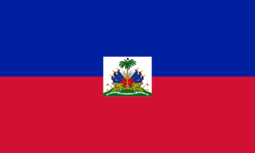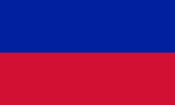Flag of Haiti facts for kids
 |
|
| Name | Bicolour |
|---|---|
| Use | State and war flag, state and naval ensign |
| Proportion | 3:5 |
| Adopted | 26 February 1986 |
| Design | A horizontal bicolour of blue and red, charged with the coat of arms in a small white box in the center. |
| Designed by | Catherine Flon |

Variant flag of Haiti
|
|
| Use | Civil flag and ensign |
| Proportion | 3:5 |
| Adopted | 26 February 1986 |
| Design | A horizontal bicolour of blue and red. |
| Designed by | Catherine Flon |
The flag of Haiti (called drapeau d'Haïti in French and drapo Ayiti in Haitian Creole) is a special flag with two horizontal stripes. The top stripe is blue, and the bottom stripe is red. In the middle, there's a white rectangle with Haiti's national symbol. This symbol shows a group of weapons on a green hill, with a palm tree that stands for freedom. On top of the palm tree is a Cap of Liberty, which is a symbol of freedom. Below all this, a white ribbon says L'Union fait la Force, which means 'Unity makes strength'. This motto reminds everyone that working together makes a nation strong.
Contents
What Does the Flag Look Like Today?
The National Flag's Design
The flag you see today was first used in 1806 by the Republic of Haiti, led by President Alexandre Pétion. It was officially brought back on February 25, 2012. The country's constitution describes the flag very clearly.
It says the flag should have:
- Two horizontal stripes of the same size. The top stripe is blue, and the bottom one is red.
- In the center, on a white square, you'll find the Coat of Arms of the Republic.
- The Coat of Arms shows a palm tree with a Cap of Liberty on top. Below the palm leaves, there's a collection of weapons. The words "L'Union fait la Force" (Unity makes Strength) are also there.
Even though the constitution mentions a "white square" for the coat of arms, it's usually shown on a rectangle that is a bit wider than it is tall (with an 11:9 ratio).
Haiti's flag is quite unique! It's one of only a few national flags that actually show a picture of a flag within their own design. Other countries with flags like this include Bolivia, the Dominican Republic, and Ecuador. Also, Haiti's flag is one of only four flags of UN member countries that feature a gun as part of their design. The others are Mozambique, Guatemala, and Bolivia.
The Civil Flag
There is also a simpler version of the flag, called the civil flag. This flag is used by regular citizens and does not have the coat of arms in the middle. It's just the blue and red stripes.
Flag Colors and Their Codes
The colors of the Haitian flag are very specific. Here's a table showing the exact color codes used for the blue, red, white, yellow, and green parts of the flag and its coat of arms:
| Blue | Red | White (arms) | Yellow (arms) | Green (arms) | |
|---|---|---|---|---|---|
| RGB | 0/32/159 |
210/16/52 |
255/255/255 |
241/181/23 |
1/106/22 |
| Hexadecimal | #00209f |
#d21034 |
#ffffff |
#f1b517 |
#016a16 |
| CMYK | 100/80/0/38 |
0/92/75/18 |
0/0/0/0 |
0/25/90/5 |
99/0/79/58 |
A Journey Through History: How the Flag Changed
The First Haitian Flag
The very first flag made only for Haiti was chosen on May 18, 1803. This happened during an important meeting called the Congress of Arcahaie, a town north of Port-au-Prince.
A popular story in Haiti tells us how this first flag was made. The leader of the revolution, Jean-Jacques Dessalines, took a French flag (which had blue, white, and red stripes). He tore out the white middle stripe, saying it represented the colonizers. Then, he asked his god-daughter, Catherine Flon, to sew the blue and red stripes together. The blue stripe came to represent the Black citizens of Haiti, and the red stripe represented people of mixed race. This story is very important in Haiti. Every year, May 18 is celebrated as Flag and Universities Day, and Catherine Flon's image has even been on Haitian money and stamps!
Changes Over Time
After Dessalines became Emperor Jacques I, he introduced a new constitution in 1805. In this new plan, the flag colors were changed to black and red. This black and red flag was later used by another leader, Henri Christophe.
However, a group of leaders who wanted a republic, led by Alexandre Pétion, decided to go back to the blue and red colors. They also changed the stripes to be horizontal and added the new Haitian coat of arms to the center.
Later, during the time of the Haitian Empire under Faustin I, his special coat of arms was used on the flag for official events. But this design was changed back after he left office.
Haiti's Flag and Other Countries
Did you know that until 1937, the flag of Liechtenstein looked exactly like Haiti's civil flag (plain blue and red horizontal stripes)? People noticed this similarity at the 1936 Summer Olympics. Because of this, Liechtenstein added a golden crown to its flag so it would be unique.
Between 1964 and 1986, during a period when the Duvalier family led the country, the flag design changed again. They went back to the black and red colors that Dessalines had used. The national coat of arms was still on the flag, but the flags shown within the coat of arms were also changed to black. This black and red flag from the Duvalier period also has a similar look to the current flag of Angola.
-
Flag during United States occupation of Haiti (1915–1934)
See also
 In Spanish: Bandera de Haití para niños
In Spanish: Bandera de Haití para niños
- Haitian Flag Day
- Flag of the Duvalier dynasty — similar flag to both Dessalines, Christophe and the current flag of Angola
- List of Haitian flags
- Coat of arms of Haiti
- Flag of France
- Flag of Liechtenstein














